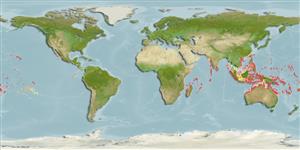Common names from other countries
Environment: milieu / climate zone / depth range / distribution range
Ecología
marino asociado a arrecife; rango de profundidad 1 - 30 m (Ref. 58302), usually 2 - 10 m (Ref. 89972). Tropical; 25°N - 24°S
Indo-Pacific: Chagos Islands and Reunion (Ref. 53568), to Panama, north to Japan and the Hawaiian Islands, south to Tonga and Mangaréva.
Tamaño / Peso / Age
Maturity: Lm ? range ? - ? cm
Max length : 250 cm TL macho / no sexado; (Ref. 30874)
Short description
Morfología | Morfometría
Espinas dorsales (total): 0; Radios blandos dorsales (total): 0; Espinas anales 0; Radios blandos anales: 0; Vértebra: 141 - 147. Each posterior nostril which is located in front of, and above the eye, is large and surrounded by a fleshy rim, and each anterior nostril bears a bilobed fleshy protuberance which is absent in species of Enchelycore.
Inhabits areas with strong surge such as benches, outer reef flats and reef fronts (Ref. 9710). Benthic (Ref. 58302). Very secretive during the day; feeds on fishes and octopi at night (Ref. 9710). May bite by accident or when provoked.
Life cycle and mating behavior
Madurez | Reproducción | Puesta | Huevos | Fecundidad | Larva
Myers, R.F., 1991. Micronesian reef fishes. Second Ed. Coral Graphics, Barrigada, Guam. 298 p. (Ref. 1602)
IUCN Red List Status (Ref. 130435)
CITES (Ref. 128078)
Not Evaluated
Threat to humans
Traumatogenic (Ref. 2334)
Human uses
Más información
ReferenciasAcuiculturaPerfil de acuiculturaRazasGenéticaElectrophoresesheritabilidadEnfermedadesProcesamientoMass conversion
Herramientas
Special reports
Download XML
Fuentes de Internet
Estimates based on models
Preferred temperature (Ref.
115969): 25.3 - 29.3, mean 28.4 (based on 2558 cells).
Phylogenetic diversity index (Ref.
82804): PD
50 = 1.0000 [Uniqueness, from 0.5 = low to 2.0 = high].
Bayesian length-weight: a=0.00050 (0.00025 - 0.00101), b=3.26 (3.10 - 3.42), in cm Total Length, based on LWR estimates for this (Sub)family-body shape (Ref.
93245).
Nivel trófico (Ref.
69278): 4.5 ±0.67 se; based on food items.
Resiliencia (Ref.
120179): Muy bajo, población duplicada en un tiempo mínimo superior a 14 años (Preliminary K or Fecundity.).
Fishing Vulnerability (Ref.
59153): Very high vulnerability (90 of 100).
